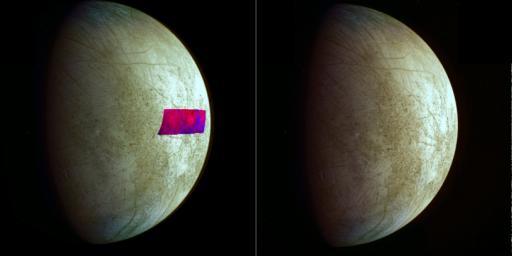
|
Clay Prints on Europa
- Click the image above for a larger view
- Full-Res JPEG (1601 x 800) (97.9 kB)
- Full-Res TIFF (1601 x 800) (3.8 MB)
Caption:
This image, using data from NASA's Galileo mission, shows the first detection of clay-like minerals on the surface of Jupiter's moon Europa. The clay-like minerals appear in blue in the false-color patch of data from Galileo's Near-Infrared Mapping Spectrometer. Surfaces richer in water ice appear in red. The background image is a mosaic of images from Galileo's Solid State Imaging system in the colors that human eyes would see.
Scientists think an asteroid or comet impact could have delivered the clay-type minerals to Europa because these minerals are commonly found in these primitive celestial bodies. These kinds of asteroids and comets also typically carry organic compounds.
A version of the image without the infrared area is on the right.
Background Info:
For more information about Europa, visit: http://solarsystem.nasa.gov/europa/home.cfm .
JPL is a division of the California Institute of Technology in Pasadena.
Cataloging Keywords:
| Name | Value | Additional Values |
|---|---|---|
| Target | Europa | |
| System | Jupiter | |
| Target Type | Satellite | |
| Mission | Galileo | |
| Instrument Host | Galileo Orbiter | |
| Host Type | Orbiter | |
| Instrument | Near-Infrared Mapping Spectrometer (NIMS) | |
| Detector | ||
| Extra Keywords | Asteroid, Color, Comet, Impact, Infrared, Water | |
| Acquisition Date | ||
| Release Date | 2013-12-11 | |
| Date in Caption | ||
| Image Credit | NASA/JPL-Caltech | |
| Source | photojournal.jpl.nasa.gov/catalog/PIA17658 | |
| Identifier | PIA17658 | |
